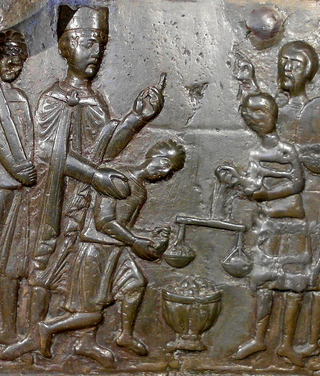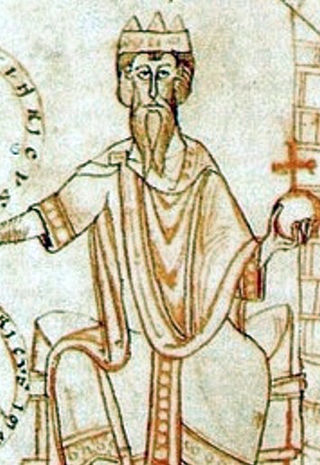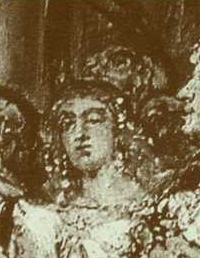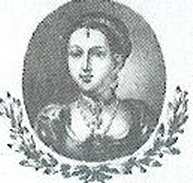
Mieszko II Lambert was King of Poland from 1025 to 1031 and Duke from 1032 until his death.
Mieszko I was Duke of Poland from 960 until his death in 992 and the founder of the first unified Polish state, the Civitas Schinesghe. A member of the Piast dynasty, he was the first Christian ruler of Poland and continued the policies of both his father Siemomysł and his grandfather Lestek, who initiated a process of unification among the Polish tribes and the creation of statehood.

Bolesław I the Brave, less often known as Bolesław the Great, was Duke of Poland from 992 to 1025 and the first King of Poland in 1025. He was also Duke of Bohemia between 1003 and 1004 as Boleslaus IV. A member of the Piast dynasty, Bolesław was a capable monarch and a strong mediator in Central European affairs. He continued to proselytise Western Christianity among his subjects and raised Poland to the rank of a kingdom, thus becoming the first Polish ruler to hold the title of rex, Latin for king.

Conrad II, also known as Conrad the Elder and Conrad the Salic, was the emperor of the Holy Roman Empire from 1027 until his death in 1039. The first of a succession of four Salian emperors, who reigned for one century until 1125, Conrad ruled the kingdoms of Germany, Italy and Burgundy.

Bolesław III Wrymouth, also known as Boleslaus the Wry-mouthed, was the duke of Lesser Poland, Silesia and Sandomierz between 1102 and 1107 and over the whole of Poland between 1107 and 1138. He was the only child of Duke Władysław I Herman and his first wife, Judith of Bohemia.
Casimir I the Restorer, a member of the Piast dynasty, was the duke of Poland from 1040 until his death. Casimir was the son of Mieszko II Lambert and Richeza of Lotharingia. He is known as the Restorer because he managed to reunite parts of the Kingdom of Poland after a period of turmoil. He reincorporated Masovia and conquered Silesia and Pomerania. However, he failed to crown himself King of Poland, mainly because of internal and external threats to his rule.

The Kingdom of Poland was a monarchy in Central Europe during the medieval period from 1025 until 1385.

Zbigniew, was a duke of Poland during 1102–1107. He was the first-born son of Władysław I Herman and Przecława, possibly a member of the Prawdzic family.

Bezprym was the duke of Poland from 1031 until his death. He was the eldest son of the Polish king Bolesław the Brave, but was deprived of the succession by his father, who around 1001 sent him to Italy in order to become a monk at one of Saint Romuald's hermitages in Ravenna.
Odon of Poznań, also known as Odon of Greater Poland and Mieszkowic, was Duke of Greater Poland in 1179–1181, and Duke of Kalisz from 1193 to 1194.

Judith of Hungary was a Hungarian princess and member of the Árpád dynasty. She was briefly married to the Piast duke of Poland, Bolesław the Brave.
Otto Bolesławowic (1000–1033) was member of the House of Piast. He was the third son of King Bolesław the Brave of Poland. Having inherited no land from his father, he fled to Germany. After the defeat of his brother Mieszko II Lambert in 1032, Otto received a part of Poland to rule but died shortly after.
Agnes of Poland was a member of the House of Piast and by marriage princess of Pereyaslavl and Volynia and grand princess of Kiev since 1168.

The period of rule by the Piast dynasty between the 10th and 14th centuries is the first major stage of the history of the Polish state. The dynasty was founded by a series of dukes listed by the chronicler Gall Anonymous in the early 12th century: Siemowit, Lestek and Siemomysł. It was Mieszko I, the son of Siemomysł, who is now considered the proper founder of the Polish state at about 960 AD. The ruling house then remained in power in the Polish lands until 1370. Mieszko converted to Christianity of the Western Latin Church in an event known as the Baptism of Poland in 966, which established a major cultural boundary in Europe based on religion. He also completed a unification of the Lechitic tribal lands that was fundamental to the existence of the new country of Poland.
The Treaty of Merseburg of 1033 was an agreement between the Salian Holy Roman Emperor Conrad II and the Piast king of Poland Mieszko II Lambert, settling the question of Polish succession which had been contested between Mieszko Lambert and his half-brothers Bezprym, Otto, and Dytryk, since the death of Bolesław I the Brave. Poland was divided into three parts with Mieszko Lambert designated as the supreme ruler. In exchange for the Emperor's support however, Mieszko was forced to renounce the title of king, which had been acquired in 1025 by his father and give up control over Lusatia and Upper Lusatia. Soon after the treaty was concluded, however, Otto died of natural causes and Mieszko prevented Dietric from assuming power in his portion of the divided Poland. Mieszko also subsequently continued to use the title of king until his death shortly after the treaty in 1034.

This is the 1003-1018 German-Polish War. For a list of all Polish-German Wars, see Polish-German Wars.

The siege of Niemcza took place during three weeks in August 1017, in the last phase of the German–Polish War (1002–18), when the forces of the Emperor Henry II besieged the town of Niemcza controlled by the Polish ruler Bolesław I the Brave. Despite the aid of Bohemian and Lutici allies, the Imperial attack was ultimately unsuccessful, according to medieval chronicler Thietmar of Merseburg due to the arrival of reinforcements which managed to break into the city and the illness among the German forces. The failure of the siege marked the end of Henry's campaign in Poland and led the emperor to agree to the Peace of Bautzen in 1018, which left the eastern March of Lusatia and the Milceni lands under Polish control.
Dytryk – Polish duke in 1032.

The Crisis of the Piast dynasty was a period of constant wars, invasions and rebellions, lasting from the death of Bolesław the Brave in 1025 until the reunification of the Polish lands by Casimir the Restorer. During the crisis, Poland suffered very severe material and demographic losses, the Polish capital Gniezno was completely destroyed, Lusatia and Milsko were taken over by the Germans, Bełz by Kievan Rus and Moravia and initially Silesia by Bohemia. This period ended in 1058 after Casimir the Restorer unified the country, but the Polish state was greatly weakened.













